Depending on the degree of deformation, a distinction is made between mild, moderate and severe forms of clubfoot.
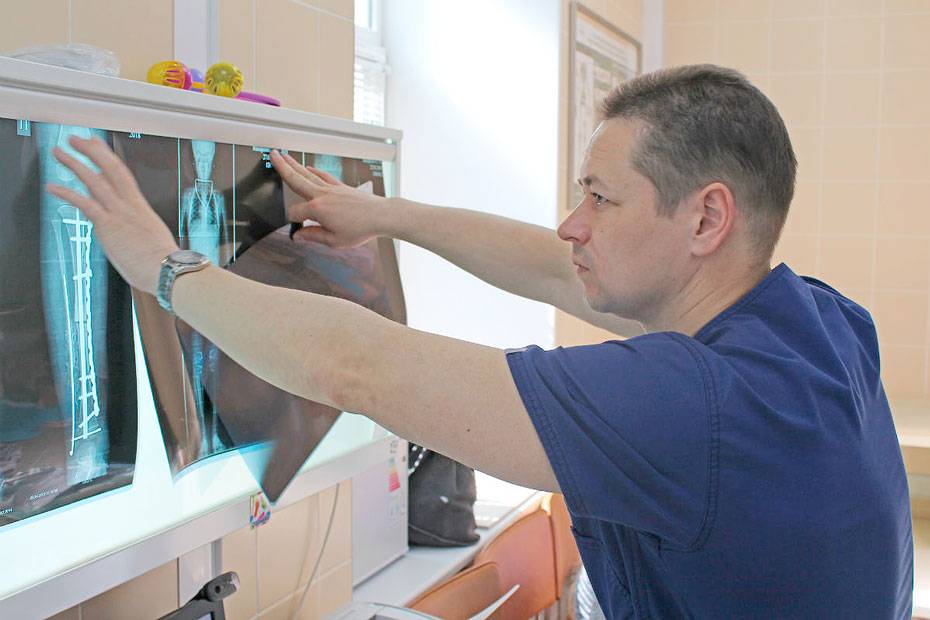
- Clubfoot recurrence
- Among the more complicated forms of recurrence are those that occur
- Clubfoot in children 7 years and older
- Split foot in children
- How to correct a clubfoot
- PHYSICAL THERAPY
- signs
- dangers of the disease
- Clubfoot in children: treatment with exercises
- When should I start treating clubfoot?
- What are the symptoms of clubfoot?
- Causes of the occurrence of the disorder
- What symptoms indicate a problem?
- Clubfoot recurrence: causes and symptoms
- Do recurrences occur after clubfoot treatment with the Ponseti method?
- What are the causes of recurrences?
- Prevention of clubfoot recurrence
- What should parents do to reduce the risk of clubfoot recurring?
- Which orthosis is best for preventing clubfoot recurrence?
- Humanism is coming
- Invisalign knot in the center of the sole
- Treatment options for clubfoot in children and adults
- Prevention of clubfoot
Clubfoot recurrence
Clubfoot recurrence occurs after any treatment. Statistically, the fewest recurrences of clubfoot occur after treatment with the Ponseti method. This fact was noted by many pediatric orthopaedists in their studies. The most important protection against a relapse is wearing the orthosis according to a set routine. When wearing the orthoses, parents have many questions about the correctness of wearing the orthoses, the duration of wearing the orthoses, etc. There are parents of children with healed clubfoot who neglect the doctor's recommendations, with the result that these children have a have a high risk of recurrence. Ignacio Ponseti himself found in his research that relapses occur less frequently in families that strictly follow the doctor's recommendations.
The relapses vary in severity, so let's go through them in order. We would like to tell you which recurrences our specialists distinguish and what treatment options they offer.
The first group of recurrences is the group of children under 1 year old with a treated clubfoot and is mainly related to the mismatch between the foot and the orthosis. In this case, when wearing the orthosis, the foot 'slips' for a variety of reasons, rubs against footwear and shortens the time the orthosis is worn to allow the wounds to heal. The result is a relapse after treatment due to incorrect wearing of the orthosis.
To correct the deformity, the patient must receive a second-stage cast and a first or second achillotomy. This is the easiest type of relapse and is seen in children under the age of one. Achillotomy can be performed under local anesthesia at this age. In this case, the most important thing is to recognize the recurrence in good time and to consult a specialist. In most cases, it is enough to send a photo of the child's feet to [email protected] so that the specialist can confirm the recurrence. After clubfoot treatment, it is therefore important to strictly follow the doctor's instructions and to take wearing the orthosis seriously, as well as to visit the doctor every three months during the first year of treatment.
Among the more complicated forms of recurrence are those that occur
- inadequate treatment of clubfoot, which can lead to secondary deformity with cast;
- incomplete correction during treatment when it is not possible to treat clubfoot with a stepwise cast and achillotomy (5 cases per 100 patients);
- relapse after surgical treatment (the presence of a skin-tightening scar does not always allow correction of the deformity with plaster);
- Non-diapathic clubfoot.
Recurrences of these forms can occur between the ages of 0 and 15 years. The treatment plan is drawn up by the specialist after a direct examination and the results of further tests.
Treatment of a recurrence begins with a gradual cast to reduce surgical intervention. The choice of surgical method of correction depends on the results of the plaster cast.
Experts point out that the decision to undergo surgery is influenced by the biomechanics of the foot. If the biomechanics are intact and the deformity is mobile, the deformity can be corrected with a cast and tendon/muscle lengthening by offloading the foot.
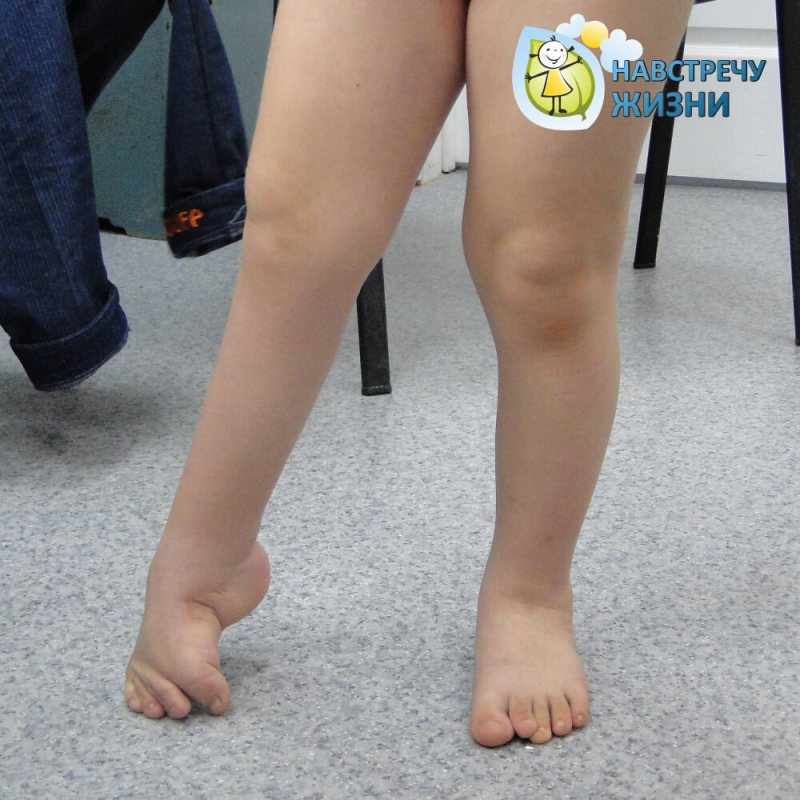
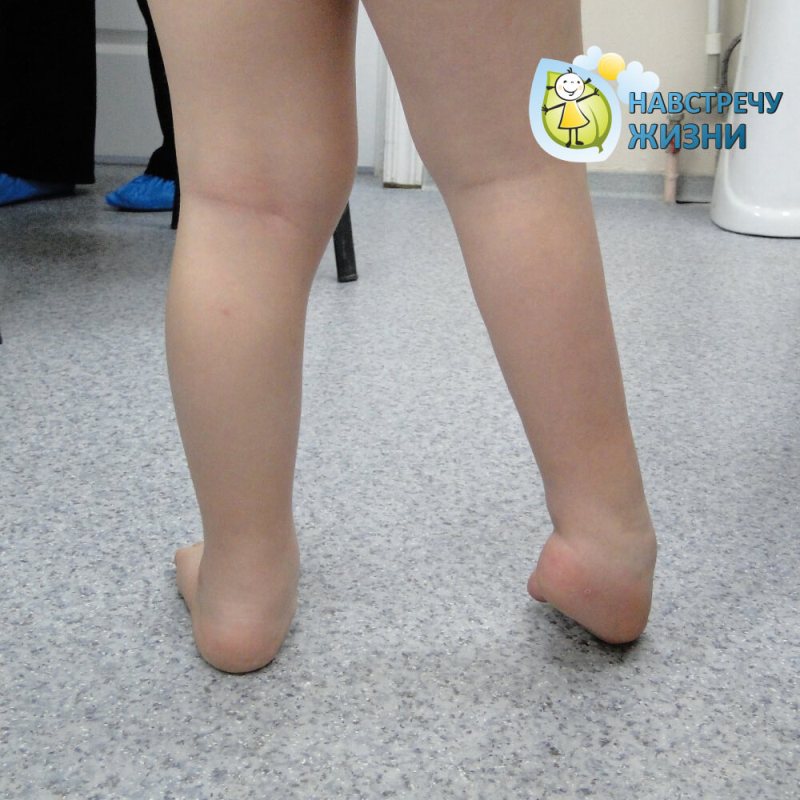
If the biomechanics of the foot are disturbed, pediatric orthopedists suggest bone surgery (osteotomies, arthrodeses). The choice of treatment plan is left to the treating physician.
If you have any questions about the treatment of clubfoot of any form and age, please contact [email protected].
Clubfoot in children 7 years and older
Newborns often have Storage Clubfootrelated to intrauterine mechanical factors. The foot is of normal size, the deformity is moderate and can be corrected with passive manipulation. In the case of severe postural defects, parents must be taught passive exercises to correct them.
Clubfoot equinovarus – A complex deformity in which the entire foot is inverted and supinated and the forefoot is adducted. The heel is rotated inward and is in a plantar flexed position. The affected foot is shortened and the lower leg muscles are worn down.
position Foot is fixed and cannot be fully corrected. In many cases both feet are affected. The incidence of equinovarus deformity is 0.9 per 1,000 live births and is more common in males (male to female ratio 2:1).
There is an inheritance predisposition to this disease (polygenic inheritance), it can also develop secondary to malformations during pregnancy or as one of the manifestations of multiple malformations or neuromuscular diseases (including spina bifida). There is an association with hip dysplasia.
The treatment should be initiated immediately (while the tissues of the foot are still malleable) and involves repair (gradual stretching and compression of the tissues) or the gradual application of plaster casts. If these measures are sufficiently effective, treatment may be discontinued or limited to overnight splinting. Corrective treatment is often required for severe deformities.
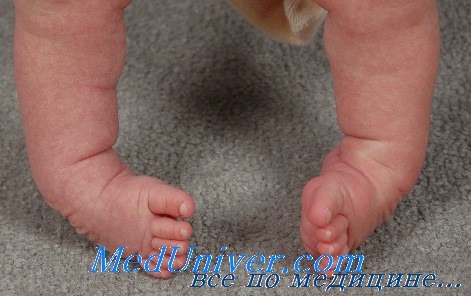
Split foot in children
split foot is characterized by an increased curvature of the arch of the foot. In older children, it usually occurs with neuromuscular disorders such as Friedreich's ataxia and hereditary motor-sensory neuropathy type I.
In the presence of pain or other symptoms may require treatment.
Equinovarus foot deformity in children:
– A differential diagnosis of clubfoot is required.
– Neuromuscular diseases, spinal lesions and hip dysplasia should be ruled out.
Publisher: Iskander Milewski. Release update date: 3/18/2021
The information contained on this website must be consulted with your doctor and is not a substitute for a direct consultation with your doctor.
Please refer to your User Agreement for further details.
How to correct a clubfoot
The diagnosis of clubfoot is not an irrefutable finding. To prescribe treatment, you need to see an orthopedist/traumatologist. Based on the general clinical picture (type of clubfoot, shape, concomitant diseases), the doctor should make a diagnosis and choose the best method of treatment. In the case of congenital clubfoot, it is important to see a specialist immediately, as the infant's ossification is incomplete in the first three weeks of life. The tissues that make up the tendons and ligaments in the feet retain their elasticity, allowing the feet to be quickly aligned and the defect corrected. Treating clubfoot in children under the age of one is statistically associated with a much lower risk of recurrence. The older the child is, the more severe the problem becomes. Four basic techniques are used to treat clubfoot:
The foot deformity is detected at the first examination of the child, so the massage sessions are usually carried out in the maternity ward. Each type of clubfoot treatment is a combination of methods. The massage is usually combined with fixing the feet in the right position using elastic bandages and clamps. The doctor stretches the posterior shin muscles and the muscles of the plantar area with massaging movements. When correcting the foot position, special splints are used for mild forms of clubfoot.
In more severe cases, the feet are corrected in stages. Between massage sessions, soft bandages or special removable devices, plaster splints, are used, which provide stronger fixation and keep the child's foot in the correct position. In this case, the ligaments and muscles 'get used' to it. In severe forms, treatment must be continued even after discharge from the hospital. The child requires special care that cannot be provided at home.
Professionals keep applying bandages to keep the legs in the correct position. These treatments are punctuated by massages. The stockings are removed every week to correct the position of the feet. It often takes at least five sessions for a child's feet to return to normal, but the effectiveness of combination therapy is directly related to the severity of the clubfoot and the time of its discovery.
PHYSICAL THERAPY
LFC sessions are usually combined with soft patches to keep the foot in the right position. Sessions are prescribed for children 2-3 years old. During these sessions, the following exercises are performed:
- Rolling the foot from toe to heel.
- Walk with feet apart.
- Walk on a pole on the floor.
- Supported squats with the whole foot.
These exercises work the adductors and the adductor muscles of the lower limbs. The child learns to put the foot in the right position, which becomes a habit with regular practice.
signs
Physical appearance of clubfoot The foot is pointing inward and upward, with the sole pointing inward and the toes tipped inward. When walking, the child does not use the whole foot, but only the outer edge of the foot, which gives the child a special gait.
Later, without proper treatment, this condition will only worsen. The skin of the outer edge of the foot becomes rough. The bones begin to deform and the joints become subluxated. The muscles of the lower leg that are not involved in walking gradually atrophy. The function of the knee joints deteriorates.
dangers of the disease
Missing the time to correct the deformity can lead to the following complications
- Partial dislocation of the foot bones;
- full contraction of muscle tissue in the lower leg;
- curvature of the knee joint;
- deformation of the spine;
- Bone damage in the foot.
The podiatrist will send the patient for a CT scan, an ultrasound, and an X-ray of the foot to identify any abnormalities and make a diagnosis.
Clubfoot in children: treatment with exercises
These are passive and active exercises, and the choice is made by the doctor for the individual young patient. Again, the exercises most commonly used in the treatment of clubfoot in children cannot be blindly copied. The complex is calculated based on the severity of the disease, the chosen methods of therapy, the stage of the therapeutic process and the age of the child. Physical activity indicated when children have elastic bones is prohibited for older children. Our patients' parents are given a full range of physical activities. A visit to the exercise room to practice the movement is possible.
Special orthoses are recommended for permanent wear. These are distinct from those sold under that name in mass stores. These are prophylactic shoes that do not have a therapeutic effect and are so called for marketing purposes.
Original orthopedic insoles, shoes and orthoses are exclusively made to order. They must not be passed on to other children, including members of the same family, and it is recommended that they be changed when correcting foot alignment.
In our center you can have individual insoles made using Sursil Ortho technology, get a prescription for orthopedic braces (shoes with a metal splint inside) and orthoses.
When should I start treating clubfoot?
Untreated clubfoot will certainly make it difficult for your child to learn to walk properly, so doctors usually recommend treating it almost immediately after birth. Fortunately, most experienced clubfoot doctors successfully treat clubfoot without operating on it.
The following measures, among others, are recommended for prevention
– wearing orthopedic insoles
– comfortable shoes of appropriate size; in some cases, orthopedic therapy shoes are recommended
– With regular massage, massage mats can be used, which are ideal for barefoot massage due to their natural roughness.
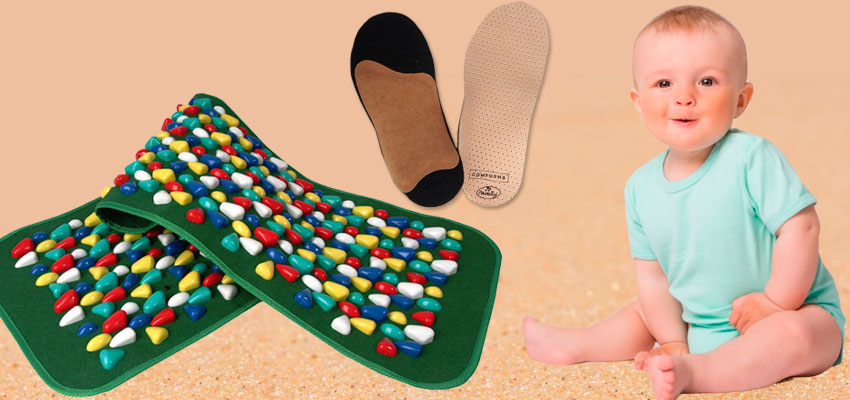
What are the symptoms of clubfoot?
There are different forms of clubfoot with different degrees of severity. Many cases are discovered at prenatal diagnosis, while some forms of clubfoot are not recognized immediately, i.e. before birth. The most common forms of clubfoot in children include deformities in which:
- The upper part of the child's foot is bent downwards and/or inwards. This increases the arch of the foot and causes the child's heel to rotate inward.
- In severe cases of clubfoot, the child's foot may be severely twisted, as if it were upside down.
- Sometimes the foot or the foot is slightly shorter than the other foot. If the deviation is not severe, it can be corrected with corrective orthopedic shoes.
- In many cases of clubfoot, the corresponding muscles of the calf and lower leg are also usually underdeveloped.
Causes of the occurrence of the disorder
- Genetic – occurrence of the pathology as a result of an abnormal expression of the organ.
- Mechanical – abnormal position of the fetus in the uterus.
- There are also muscular, neuromuscular, and a number of other theories about how the disorder develops.
Nowadays, more and more experts assume that the congenital malformation is an expression of a pronounced dysplastic process (intrauterine organ involvement) of the whole body, in which the nervous, muscular, vascular and skeletal systems of the lower limbs are equally affected.
What symptoms indicate a problem?
Clubfoot at birth manifests itself as a deformity of the foot. It is not painful, but as it grows it can cause significant discomfort and limit the ability to walk. It does not resolve spontaneously (without treatment). The deformation only increases, and the child's ability to walk is severely limited. In addition, the symptoms increase as the child grows older. As a result, the child cannot walk, run, play sports, play, etc. Serious problems arise when choosing footwear.
Almost two and a half thousand years ago, Hippocrates attempted to treat children using manual manipulations and splints. The 19th century pioneered the use of plaster casts to immobilize the feet. Today there are many different conservative and surgical techniques, but the 'gold standard' is the Ponseti method, developed in the 1950's by Dr. Ignacio Ponseti was proposed. The specialists of our center have extensive practical experience in the use of this technique, which has already successfully cured more than a dozen patients.
Clubfoot recurrence: causes and symptoms
Do recurrences occur after clubfoot treatment with the Ponseti method?
Of course, even with the Ponseti method, clubfoot recurrence occurs in about 1 in 4 patients under the age of 5. And in most cases, they can be easily corrected. A short cast and an achillotomy with transfer of the anterior tibial tendon are usually sufficient. The scope of treatment depends on the severity of the disease and is determined by the attending physician. After 5 years of age, the probability of recurrence decreases to 5 % of the total number of recurrences and occurs during pubertal growth.
What are the causes of recurrences?
Recurrences of congenital malformations of the musculoskeletal system are treated by orthopedists worldwide. Clubfoot is no exception. Loss of correction against growth occurs in 25 % of the children.
Difficult recurrences result from incorrect treatment of the clubfoot or incomplete correction.
However, the most common recurrence is due to failure in the last phase of clubfoot treatment - wearing a splint.
Syndromes and combinations of damage to the nervous and musculoskeletal systems rarely result in a loss of correction. In conversations with parents whose children have suffered a recurrence of clubfoot, it usually turns out that the orthodontic regimen was not followed correctly. This is the main cause of recurrence.
- The child stays in the orthosis for less time than recommended. This problem occurs in the first days of wearing the orthosis or, on the contrary, at the end of treatment, at the age of 2-3 years. In the first case, parents take pity on the crying child, uncomfortable and not used to wearing such shoes, and remove the orthosis. In the second case, they let off steam: the foot looks good, so they stop putting the orthosis on the child at night and don't call the doctor. But the child is actively growing, so after 3-6 months of such a regimen, the risk of recurrence of clubfoot increases significantly.
- Errors in wearing orthoses.
- Wrong size.
Prevention of clubfoot recurrence
What should parents do to reduce the risk of clubfoot recurring?
- Stick to the time specified in the orthosis protocol.
Parents should be aware that after the cast and achillotomy, clubfoot treatment is not over but has entered a maintenance phase. The most important thing in clubfoot prophylaxis is therefore the provision of a plaster cast and observation by the doctor treating you. The orthopedist actively monitors the children until they stop growing.
The easiest and safest way is to wear orthotics. These are shoes that are attached to a rail at a specific angle that is adjusted as the child grows. In this phase, the main task of the parents is to wear the orthoses correctly and strictly adhere to the carrying system. In the first 3 months, the child should wear the shoe 23 hours a day. After that, according to the wearing protocol, the time in the orthosis is gradually reduced and it should only be worn during all types of sleep. A child who attends kindergarten at the age of two can do without an orthosis. However, wearing the orthosis at home is mandatory.
According to studies, families who followed the brace-wearing protocol and strictly followed the doctor's recommendations had very few recurrences.
Which orthosis is best for preventing clubfoot recurrence?
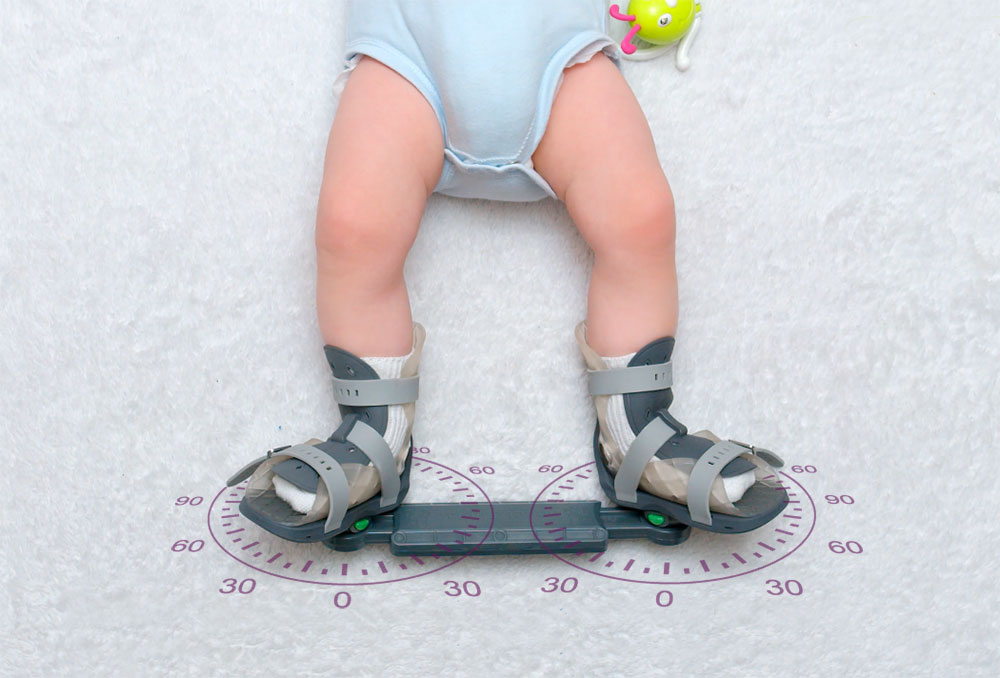
We recommend orthoses with a static bar. Currently, braces Kinetic Pro (made in Russia), Mitchell (made in the UK) and Alfa-flex (made in Germany) are very popular. I would like to point out that for recurrence prevention it is very important to set the dorsiflexion to 15-20 degrees for the clubfoot and 0 degrees for the vertical and oblique arm. The Kinetic Pro Home Braces feature a ball joint mechanism that allows the dorsiflexion angle to be individually adjusted for a specific therapy. This nuance very favorably distinguishes them from their foreign counterparts. And of course, the affordable price of the Kinetic Pro model is a strong argument in their favor.
Humanism is coming
The 'Constanta' clinic is located in the entrance area of a five-storey building. Maxim Vavilov, a military-looking man with a short haircut, greets me at the entrance and immediately rushes to the operating room with his colleagues Ilya Gromov and Ekaterina Solovieva: the operation is in half an hour. Before I have time to think anything, I take them in the elevator to the fifth floor, to a small children's ward with a playground in the hallway. Vavilov looks in one branch and in the other. And probably enters the third.
– 'Are you Soroka? Hello, hello!' he greets the little brunette sitting on the bed. The little girl looks anxiously from one doctor to the other.
Rusfund's four-year-old protégé, Eva Soroka. Eva Soroka. from Krasnodar, has a plaster cast on his left leg at knee level. The plaster is marked in blue.
– What a beautiful cast you have! Did dad draw him? – Vavilov bends over her.
The girl smiles shyly. Her mother explains that Eva had a Ponseti cast as an infant and wore medical shoes – braces – until she was three years old. It's a kind of shoe with a bridge - people on the street mistake it for a skateboard, even though they don't have wheels. After the brace was removed, her left foot began to deform.
- We didn't know you had to wear braces (or at least sleep in them) until you were five or six years old,' my mother explains. – Our orthopedist suggested a major operation, which leads to a relapse. We decided to come here to see a specialist. So Eva has been in a cast for a fortnight to stretch the ligaments and is having a minor surgery today.
The anesthetist comes to see Eva, and the orthopedists and I rush to get the mobile Vavilov back into the elevator - now on the third floor, in the operating room. Vavilov gives me sterile pants and a dressing gown and explains:
– Clubfoot has always been treated with casts and surgery, but the methods have become more humane over time. Just 15 years ago we operated on clubfoot differently. We cut open the skin around the ankles, then severed the tendons and muscles, exposing the joint. A cast was put on and we waited for all the tissue to heal. All operated patients were left with ugly scars. Most had a sore feeling and a foot with little mobility. A third returned to the operating table with a recurrence. Today, 98 % patients are alive after Ponseti casts without recurrence and without surgery. For the rest, recurrences are mostly due to errors in bracing, as in the case of Eva Soroka.
Invisalign knot in the center of the sole
While we are getting dressed, little Soroka has already fallen asleep on the operating table. There we don't even see the sleeping girl, but her leg: the rest is covered with green disposable diapers. The girl has a tourniquet on her thigh to stop the flow of blood. Vavilov rubs the leg with a large tampon soaked in iodine. The leg turns yellow. The doctor wraps the leg from toes to the knee with an elastic bandage and holds it upright for a minute to bleed completely. After unpacking it, he puts it on the table. The yellowish leg now looks like a silicone trainer.
With the first tiny incision above the heel, the doctor literally cuts through the Achilles tendon in seconds to lengthen it. This microsurgical procedure, the Achilles tendon removal, is not spectacular at all. Many children with clubfoot are given a local anesthetic in the presence of their parents.
The doctor then makes two similar bloodless incisions - a longer one along the tip of the foot. He takes a needle with a thick blue thread and begins to literally resew the tendons that look like a white braid. Just like dr. Ajbolit in the pictures of the hare. He picks up the tendon with the needle in one cut and fixes the thread in it with a few stitches, just like you learn in school. He then pulls the braid under the skin to the other incision and pulls it outward. The foot follows the strand and is immediately correct: at right angles to the shin. The doctor sews up this tendon in its new position. Then he pierces the foot with a needle and ties a nasty knot in the middle of the sole with a thread. This takes no more than 15 minutes. After that, only the incisions have to be sewn up with absorbable suture material and the foot has to be put in plaster for a few months. It's a commonly performed operation with a tooth-breaking name: transposition of the tendon of the distal tibialis anterior muscle to the third sphenoid bone of the left limb.
Treatment options for clubfoot in children and adults
The treatment options for clubfoot are conservative and surgical. An individual therapy is developed for each patient.
In the case of congenital defects, treatment should be started immediately after birth. In most cases it is possible to correct the alignment of the foot without surgery until the skeleton is fully ossified.
- foot massage;
- physical therapy to improve ankle mobility and prevent muscle wasting;
- gentle immobilization of the feet in a physiological position with special bandages;
- plaster casts (sometimes after correcting the foot with soft immobilization);
- wearing orthopedic footwear;
- physiotherapeutic treatments.
The same methods are used to treat acquired clubfoot in adults. They are very effective if the disease is diagnosed on time.
If conservative treatment is unsuccessful or the patient has severe clubfoot, the feet are surgically corrected. The surgery restores the correct alignment of the foot bones and repairs the ligaments and tendons of the foot. In children, this operation is performed after the first year of life.
Prevention of clubfoot
In order to reduce the risk of congenital deformities in children, women during pregnancy are advised to lead a healthy lifestyle, eat a balanced diet and give up unhealthy habits.
In order to prevent deformities in children, it is advisable not to put the child on its feet until the bones have grown significantly and it begins to walk independently. It is also advisable to observe the child's gait from an early age and to go to the swimming pool with them.
In addition, it is recommended for both children and adults
- walking barefoot more often on the floor or on a massage mat;
- wearing shoes of the right size that have a firm heel and raised insole;
- timely treatment of all infectious and inflammatory diseases.
A consultation with an experienced orthopedic traumatologist in Kiev is possible at the Oxford Medical Center. The clinic has all the prerequisites for diagnosing and treating clubfoot. To make an appointment, call our contact center or write in the chat on the site.
Read more:- The Ponseti method.
- Congenital clubfoot.
- Clubfoot Treatment.
- Ponseti breeches.
- 1 year old child with clubfoot.
- What is clubfoot?.
- recurrence of joints.
- Clubfoot in children therapeutic exercises 7 years old.
